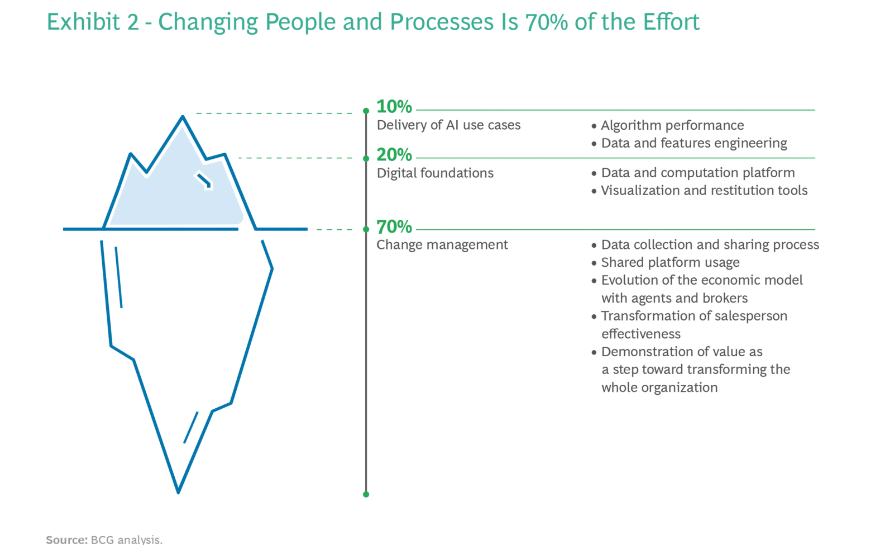health and tech
research & strategy institute
for continuous health transformation
Joaquim Cardoso MSc
Senior Advisor for Continuous Health Transformation
and Digital Health
January 9, 2023
This is an excerpt of the publication “AI, Bionic Insurance, and the 10–20–70 Rule”, with the title above, focusing on the topic in question.
July 23, 2020
Dr. Christopher Freese
With thanks to the co-author Jean-Christophe Gard
Introduction
Mature insurers all over Europe and North America have poured money into digital initiatives, including automated fraud detection and accelerated claims processes.
But these have mostly been islands of improvement, where they’ve been improvements at all.
They haven’t given the companies a sustained advantage in the marketplace.
Part of the problem is a misunderstanding of how advanced analytics and AI create value. executives tend to assume that AI’s value is mostly in the algorithms their companies develop, in the new types of data they use, and in new technology platforms.
In fact, algorithms and new technology platforms only account for about 10% and 20%, respectively, of AI’s value. Much more of the value (70%) comes from changed processes and new ways of working.

Malakoff Humanis is a good example of the 10–20–70 rule.
1.AI is 10% of the program value

At the same time, as a proof of concept, we helped Malakoff create a set of algorithms to address specific market opportunities.
One of the algorithms allowed Malakoff to become much more precise in how it marketed and priced long-term hospital care insurance (a high profit product).
Another algorithm helped Malakoff more than triple the percentage of fraudulent sick leave claims it was detecting.
The algorithms, however, were only a small proportion (10%) of the value Malakoff got from rethinking its use of data.
The algorithms, however, were only a small proportion (10%) of the value Malakoff got from rethinking its use of data.
2.Data is 20% of the program value

A few years ago, this Paris-based health and life insurer began partnering with us on its data strategy.
Malakoff believed better data management would give it a greater ability to pursue market opportunities and make use of advanced analytics.
The company also believed better data management would help it adjust more rapidly to regulatory changes.
If Malakoff was going to become better at data management, its raw data needed to be easier to access.
So we helped the company build a data lake-a platform that would store all of the legacy data Malakoff owned and that would readily accommodate new sources of data.
That accounted for 20% of the change program’s value.
So we helped the company build a data lake-a platform that would store all of the legacy data Malakoff owned and that would readily accommodate new sources of data.
That accounted for 20% of the change program’s value.
3.Change Management — organizational & process are 70% of the program value

By far the most value (70%) came from organizational and process changes.
In a bold move, Malakoff put data analysts together with business analysts, and also with sales managers and operations staff.
In addition to their usual jobs-data maintenance in the case of the data analysts, the development of marketing campaigns in the case of the sales managers-Malakoff made these teams responsible for coming up with new ideas about how to use data.
The bet is paying off.
Malakoff now has a steady stream of ideas which start as algorithms and flow through the company-to the benefit of its customers and its bottom line.
Indeed, for any insurance company, the value of being organized in this way is agility: being able to jump on emergent opportunities.
Indeed, for any insurance company, the value of being organized in this way is agility: being able to jump on emergent opportunities.

AI requires a special kind of organizational scale.
It isn’t enough for an algorithm to shed light on which customers might be open to buying an additional insurance product.
This insight about cross-selling requires supporting infrastructure in other parts of an organization: tools that agents or call-center staff can use to personalize the appeal and close the sale.
Likewise, it isn’t enough for an algorithm to highlight the product attributes that would work for different customer segments.
There must be systems, processes and people to modularize products while the window to do so is open.
Likewise, it isn’t enough for an algorithm to highlight the product attributes that would work for different customer segments.
There must be systems, processes and people to modularize products while the window to do so is open.
And of course, data itself could become a source of new ideas, certainly in those companies whose analytical and AI systems are set up to do such work.
And of course, data itself could become a source of new ideas, certainly in those companies whose analytical and AI systems are set up to do such work.
This combination of data-generated insights and human judgement and creativity is what we mean by bionic insurance.
I can practically see the “Yes, but” forming on the lips of a lot of people I know.
Most insurers don’t have legions of data scientists, data engineers, or data stewards at their disposal.
People with digital talent and new to the workforce usually want to work for a digital giant or a social media startup, or maybe an insurtech like Lemonade (which went public earlier this year to great fanfare).
They don’t want to work for a traditional insurer.
This is an obstacle that should be met with determination, not resignation.
There’s simply too much to gain by having an effective strategy for AI and analytics and cracking the code of 10–20–70.
The traditional insurers that do so will gain an immense advantage and add a touch of magic to their business.
Originally published at https://www.linkedin.com.












